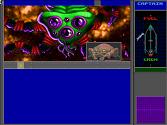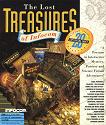Deus Ex is one of my favorite single-player games of all time. Many others have promised to provide the same things this game provides, but every time the others fall short. It is really that good. The game was released back in 2000 by Eidos for Windows computers, and has been released for Macintosh and Playstation 2 in the meantime (under the name Deus Ex: The Conspiracy).
The year is 2050. The world is in a state of chaos. The Gray Death plague runs rampant, ripping through the populace. There is a vaccine, but it is in very short supply and is primarily used for the rich and famous. Riots occur everywhere, and anti-government groups are becoming more and more prominent. To combat this, the United Nations has formed a worldwide police force called UNATCO, the United Nations Anti-Terrorist Coalition.
You take on the role of JC Denton, a rookie agent for UNATCO (United Nations Anti-Terrorist Coalition). You’re one of the prototypes of a new kind of enhanced agent. Instead of bulky and dehumanizing mechanical body parts, like your fellow agent Gunther Hermann, you are nanotechnologically enhanced. The title is a short version of “Deus Ex Machina”, which means “God from a machine”. This is a plot concept introduced in plays many centuries ago, where an apparently unsolvable situation is suddenly and miraculously solved by the unexpected intervention of a deity. The god was introduced to the stage at the time by lowering the actor mechanically from above the stage, thus coining the name. The title “Deus Ex” is particularly apt. The nanobots give you super-human abilities, which is one aspect, and also your character is the deus ex machina introduced to solve the world’s problems.
The game starts with your very first mission, which has been assigned to you as a test. UNATCO headquarters is on Liberty Island, the location of the statue of liberty. Terrorists occupy the statue with soldiers patrolling all over the grounds except the small portion of the island occupied by UNATCO. Sure, the UNATCO troops could mop these guys up with no problem, but they’d rather see what you can do.
The most unique aspect of this game is the way the missions are set up to allow multiple approaches to every scenario. These choices affect what you’ll want to carry in your inventory, how you want to interact with people, what skills you want to develop. This makes for enhanced replayability, because you can play it again with different tactics and have a very different gameplay experience. For instance, you can charge in the front door with guns blazing in classic FPS style. Or you can use lockpicks to sneak in a side door, only confronting enemy units when absolutely necessary. Or you can rely on your hacking skills, turn enemy turrets against their owners, unlock all the doors and just walk in.
Another thing that made this game great is the interweaving of dozens of conspiracy theories into one cohesive plot. The Illuminati, the Knights Templar, Men in Black, Area 51 and many others are all tied into the plot.
As you go through the game, there are so many incentives to explore. By picking a lock into a hotel room, you might find a note with an ATM code on it, a stash of money. You might find information. You might find a man with a gun ready to shoot intruders. Or you might find nothing of interest. You never know until you try. Not every area is hostile territory, but that doesn’t mean that you can’t break into shops, find contacts to buy black market goods behind hotels. You visit major world cities along the way, such as New York City and Hong Kong.
There are numerous ways to customize your game, which can make it different every time. First, you have upgradeable skills. At the beginning of the game, you’re given a set amount of skill points which you can allocate across a wide variety of skills. Many of these are weaponry skills: enhanced skill with pistol weapons, rifles, explosives, etc… Others are more general use, such as swimming skill that will help you hold your breath for longer underwater. But, to me, one skill trumps them all: hacking. Hacking is so versatile it’s useful for any situation and the more you upgrade the skill the more versatile it is. Every skill has four levels, each ascending level costing an increasing number of skill points to upgrade. At the lowest level, you are unable to hack. As you increase the skill level you’re able to affect more things when you hack, as well as have more time to do so. You can break into people’s personal computers and read their emails. You can hack into ATMs and withdraw money from other people’s accounts–although the ATMs do tend to malfunction after a single hack, never working afterward. Occasionally you come across ATM codes in emails and memos, so use the legitimate codes before hacking to maximize your cash intake. Most importantly, you can hack into automated security systems. From within the security system you can open security doors, disable laser triggers, and sometimes even turn automated machine gun turrets against their owners. You gain skill points by doing various things, such as completing primary or secondary objectives, and you also get them for unlisted objectives, such as exploring new areas to get “exploration points”
One of the things that makes this game the most unique is the upgradeable nano-augmentations. At the beginning of the game your augs are pretty basic. You have an infolink that gives you a popup comm window on your screen at anytime. Your targeting system can tell you if a person is a friend or a foe by color-coding the cross-hairs. And you have a light that you can use to see in the dark. But it uses up your battery systems, and enemies can see the light.
When you find your first nano-augmentation canister, that’s when things really start to get interesting. Each augmentation upgrades a specific aspect of your body, and can provide one of two enhancements, but once you choose one of the two, the change is permanent, and you can never go try the other one. One of the canisters, for instance, upgrades your eyes. You can choose “vision enhancement”: night vision at level one, infrared vision at level 2, short-range sonar at level 3 (see through walls), long-range sonar at level 4. Or you can choose targeting, which increases your accuracy and weapon damage as well as giving you info about your target, the higher the level the more accurate and the more info. Other upgrades throughout the game include the ability to heal damage, to walk more quietly, and invisibility. Choose wisely! There are two kinds of canisters, the augmentations which you have to choose between the two types, and upgrade canisters. The upgrades can be applied to any of your augs, but remember that these things aren’t just lying around everywhere–you’ve got to choose which augmentations are most valuable to upgrade.
Another way you make the game your own: inventory choices. You have a limited (though large) amount of carrying space. You can’t carry everything you come across, nor even every type of weapon. Myself, I like a wide an array of weapons to use in different situations. Others might like to tote around bulky heavy weaponry. Whatever you do, keep in mind that you might want to hold onto each weapon as long as you can, because of weapon upgrades. Each weapon can take numerous upgrades that can affect magazine size, reload rate, and the like, so once you’ve upgraded a weapon you may want to keep it around. Some items are must-haves: med kits, LAMs (like grenades), energy canisters, to name a few, luckily these things take up only one space in the inventory and are stackable (more than one of the same type fits in the same square). Lockpicks are a worthwhile tool as they are often an investment more than a cost, and you can use less of them if you upgrade your lockpick skill.
The difficulty of the game all depends on your decisions. I’ve heard it’s possible to complete the game without killing a single human being. That would be very difficult. There are several non-lethal weapons such as the tranq. crossbow and the stun prod, but tranqs are so slow-acting that the enemy often gets to an alarm button, and the stun prod requires a direct melee attack. And what augmentations and skills you choose to upgrade all affect your available strategies and the difficulty thereof. If I wanted to make the game harder, I could skip the hacking skill entirely, but for me that would make the game much less fun, because there’s nothing quite like the rush of turning an enemy’s trusted security system against them.
Also, you can save anywhere anytime, so if you constraint yourself in this ability, the difficulty will be raised. Otherwise you could pick every lock and just re-load an old game just before the pick if you don’t like what you find. While there’s nothing in the game to prohibit this, it does take much of the challenge out if you take this strategy.
There are multiple endings to the game, though luckily the objectives for each of them are given to you. You just need to choose which ones to complete. You’re not locked into any of the endings until you perform the final task for them, so if you keep some strategically saved games you can see all three endings without having to replay the whole game.
The graphics in the game are quite good, nice textures. My only complaint is that the faces, particularly the mouths, look blocky as people speak. The music is great, and the voice acting is superb. Some have complained that JC’s voice is too deadpan, but I think it’s appropriate given his character.
Hungry for more? There is a sequel, Deus Ex 2: Invisible War, but don’t expect much from it. It has some interesting ideas, but the core principles that made the first one great are dummied down to appeal to a wider audience. In addition, the graphics engine is needlessly vamped up. I ran it on a computer above the minimum specs and it would frequently stall as it tried to handle the rag-doll bodies and dynamic shadows. Those were fun effects, but reliance on pretty graphics is merely settling when looking at a Deus Ex game. Supposedly a Deus Ex 3 is in the works, but I don’t have high hopes for it. Warren Specter, the man that is given much of the credit for the first game, is not involved in this one, and that always makes me think it’s going to subpar, and usually I’m right. I hope I’m wrong. I really do. Hopefully I will be able to write up a separate Niche Games article later about how great it is. But I wouldn’t hold your breath. There have also been talks about movie rights, but again, I don’t have high hopes for anything worthwhile to come out of that.
If you want to find this game, it shouldn’t be too hard. A quick eBay search finds copies under 20 bucks, well worth the price of this one. Deus Ex has something for everyone. You will not regret it. Go buy it now, and enjoy!

 Written by Melissa Shaw
Written by Melissa Shaw Melissa Shaw’s short fiction has appeared in
Melissa Shaw’s short fiction has appeared in  VERDICT:Â Recommend, try to read at least 50 pages to get through the slow beginning.
VERDICT: Recommend, try to read at least 50 pages to get through the slow beginning. The original Star Control was developed by Toys for Bob and released on computer platforms as well as the Sega Genesis in 1990, and is a great space combat games, pitting a diverse array of ships against each other one on one. This was followed in 1992 by Star Control II, a vast expansion on the original game, providing many more alien races, each with their own unique ship. On top of this is the very best part, the space exploration aspect, which I’ll go into more later on. Star Control 3 was developed by Legend entertainment, which was hired by Accolade to create a sequel when Toys for Bob refused to create a sequel for the same amount of money they produced Star Control II for (Toys for Bob had to work for no money for several months for that game already). It’s obvious that the original creators had nothing to do with this one. Despite its 3-D rendering of the ships, and the addition of new races with their new ships, new regions to explore, and claymation of the alien species, this game was vastly inferior to its predecessor. If you want to try the series out at its very pinnacle, try out Star Control II. Star Control 3 is okay, and may be interesting if you loved Star Control II as much as I do just as a means of holding off the impending cravings for more content. Star Control 4 was scrapped during the development stages.
The original Star Control was developed by Toys for Bob and released on computer platforms as well as the Sega Genesis in 1990, and is a great space combat games, pitting a diverse array of ships against each other one on one. This was followed in 1992 by Star Control II, a vast expansion on the original game, providing many more alien races, each with their own unique ship. On top of this is the very best part, the space exploration aspect, which I’ll go into more later on. Star Control 3 was developed by Legend entertainment, which was hired by Accolade to create a sequel when Toys for Bob refused to create a sequel for the same amount of money they produced Star Control II for (Toys for Bob had to work for no money for several months for that game already). It’s obvious that the original creators had nothing to do with this one. Despite its 3-D rendering of the ships, and the addition of new races with their new ships, new regions to explore, and claymation of the alien species, this game was vastly inferior to its predecessor. If you want to try the series out at its very pinnacle, try out Star Control II. Star Control 3 is okay, and may be interesting if you loved Star Control II as much as I do just as a means of holding off the impending cravings for more content. Star Control 4 was scrapped during the development stages.
 You are standing in an open field west of a white house, with a boarded front door.
You are standing in an open field west of a white house, with a boarded front door.